Tropical Cyclones Lam and Marcia
Status: Closed
| Type of posting | Posting date(EST): | Summary | Downloads |
|---|---|---|---|
| Landfall | 2/23/2015 6:00:00 AM |
|
Landfall | Summary
Posting Date: February 23, 2015, 6:00:00 AM
In a first for Australia, two severe tropical cyclones made landfall within a 24-hour period. The first to make landfall, Cyclone Lam, struck on the coast of the Northern Territory—a region with very low population density—and had a relatively small impact. However the second storm—Cyclone Marcia—hit the coast of Queensland, resulting in noteworthy exposure damage, power outages, travel disruption, and economic impact.
Cyclone Lam made landfall on the coast of the Northern Territory, near Milingimbi, at about 12:00 UTC February 19. Lam struck the coast as a Category 4 storm on the Australian tropical cyclone intensity scale, with estimated wind gusts up to 260 km/h (162 mph), then began to weaken as it moved over land.
Cyclone Marcia, the more impactful of the two storms, made landfall as a Category 5 storm on the Australian cyclone scale in Queensland, Australia, near Yeppoon, some 2,000 kilometers (1,200 miles) southeast of Cyclone Lam’s landfall. Cyclone Marcia had slowed as it approached land, then gained strength with surprising speed, increasing from an Australian Category 1 tropical cyclone with sustained winds of slightly higher than 100 km/h (62 mph) to a severe tropical cyclone in the Category 5 range with wind speeds approaching 230 km/h (143 mph) in just a few hours. Marcia battered Yeppoon and Rockhampton, tearing off roofs, uprooting trees, and damaging power lines. Marcia weakened overland, and as of 15:00 UTC on February 20 was a tropical low, with sustained winds of 55 km/h (34 mph), and wind gusts to 85 km/h (53 mph). Marcia, however, delivered heavy rainfall as it proceeded on its south-southwest course.
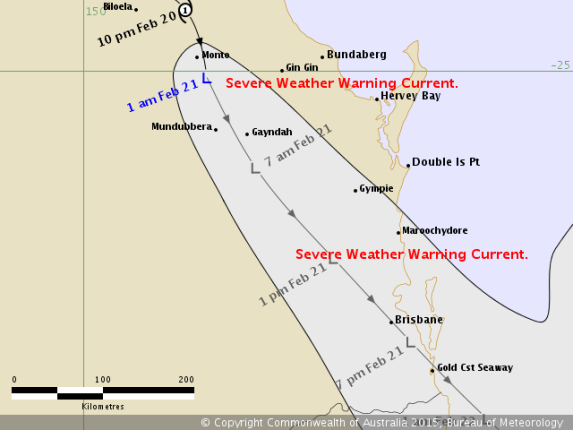
Figure 1. Storm track of Ex-Tropical Cyclone Marcia, February 20, 16:06 UTC. (Source: BOM) |
Tropical cyclones Lam and Marcia are the first cyclones this season to make landfall on mainland Australia, one of the latest arrival dates of the last 50 years, according to the Australian Bureau of Meteorology (BOM). Another Australian Category 5 tropical cyclone, Yasi, struck Queensland in February 2011 and resulted in significant damage.
Meteorological Summary
Cyclone Marcia made landfall around 23:00 UTC on February 19, approximately 60 miles north of Rockhampton as a marginal Category 5 on the Australia cyclone scale, with 10-minute sustained winds estimated at 110 knots (~127 mph). At landfall, Marcia was a highly organized system featuring a distinct eye and coherent eyewall. (See Figure 2.)
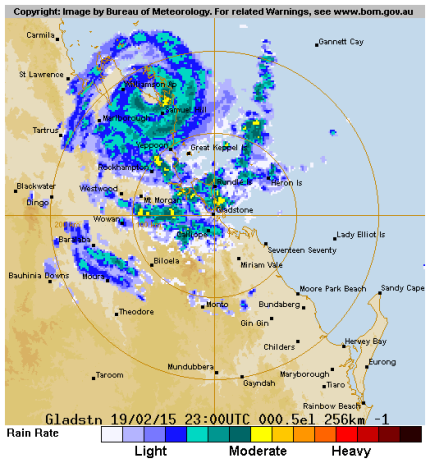
Figure 2: Radar image of Cyclone Marcia at the time of landfall. (Source: BOM) |
After landfall, Marcia weakened to a tropical low with heavy rainfall the main remaining threat. Although Marcia made landfall in a fairly sparsely populated area, as shown in Figure 3, the storm track did take it directly over Rockhampton, and the storm will eventually pass near Brisbane, where flood watches have been issued. Rockhampton and Samuel Hill have reported 214 millimeters (8.4 inches) and 317 millimeters (12.4 inches), respectively, since February 18.
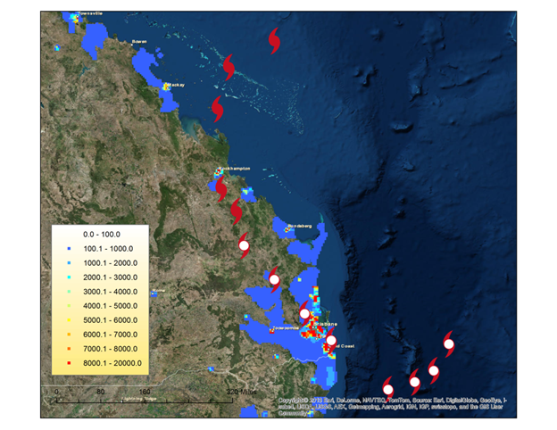
Figure 3: Observed (red symbols) and forecast (hollow red symbols) for Cyclone Marcia from the Australia BOM forecast issued at 13:11 UTC on February 20. The image also shows 2015 population estimates, on a 2.5 arc-minute (~4.5 km grid). (Source:BOM and CIESIN) |
As shown in Figure 3, when Cyclone Marcia crossed Rockhampton, the storm produced wind gusts of up to about 70 mph (~115 km/h) as both the southern and northern eyewall passed over the area, while Samuel Hill, which remained in the eastern eyewall, received wind gusts of over 100 mph (160 km/h).
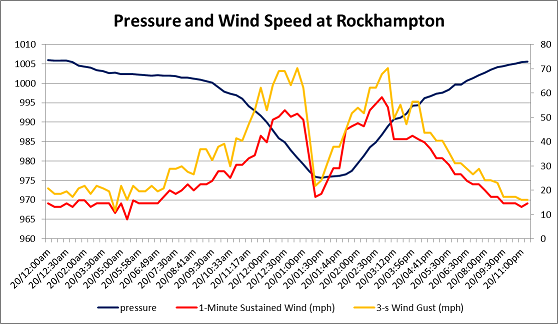
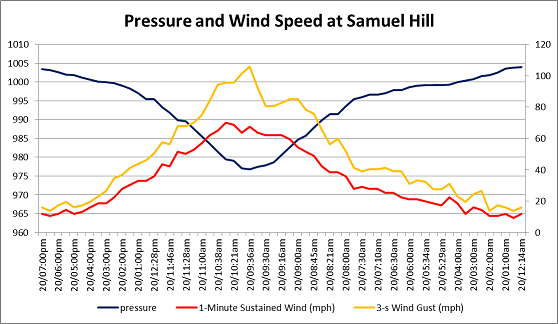
Figure 4: Observed pressure (mb) and wind speeds (mph) at Rockhampton (top) and Samuel Hill (bottom). Marcia passed directly over Rockhampton, while Samuel Hill remained in the eastern eyewall. (Source: BOM and AIR) |
Marcia is a noteworthy event, but with some caveats: Marcia is the southernmost landfalling Category 5 on the east coast of Australia on record, but it was a borderline Category 5 storm, and reanalysis may reveal that Marcia was actually a strong Category 4. Furthermore, prior to the availability of satellite data cyclone intensity at landfall was likely underestimated. Similar historical events to Marcia include Simon (1980) and Dinah (1967), although both these cyclones were Category 4.
In addition to Marcia, Cyclone Lam made landfall in the Northern Territories around 12:00 UTC on February 18, which is likely the first instance of two severe cyclone landfalls (Australian cyclone scale Category 3 or above) in Australia within 24 hours.
Exposure at Risk
With the high wind gusts expected from Australian cyclone scale Category 4 and Category 5 storms (225 km/h to more than 280 km/h [140 mph to more than 174 mph]), damage can be significant, notably to older structures. Strong building codes have been in place across north Queensland since the devastating Tropical Cyclone Tracy in 1974, improving the resilience of structures built to code.
Residential buildings in Australia are mostly single family homes, with apartments and condominiums predominantly in larger cities. Most of Australia’s residential buildings are either wood frame or masonry, many with brick veneer, and most often with metal roofs. Most homes are low-rise, so wind damage tends to impact roofs and exterior walls.
The commercial and industrial building stock in Australia is predominantly concrete and steel. Large commercial buildings, especially mid-rise and high-rise structures, tend to be engineered and are therefore more resistant to wind damage than smaller buildings. Windows and cladding on engineered structures do risk impact damage from airborne debris, of course.
The high winds also can result in overturned caravans and trailers. In addition, storms the size of Lam and Marcia uproot trees, which can result in downed power lines, blocked roads, and damaged buildings and automobiles.
Impacts and Reported Damage
In preparation for Severe Tropical Cyclone Marcia, thousands of Queensland residents were advised to remain indoors, and shelters were opened. Because of the quickness with which Marcia gained intensity as it approached land, however, emergency services were forced into a very rushed evacuation. Queensland coastal areas experienced higher-than-normal tides and some resultant flooding from the storm. Some destruction of homes in Queensland also was reported. In addition, rail lines to ports stopped operating, which deeply impacted businesses in this export-reliant region. Reportedly the sugar crop, too, was placed at risk by the storm. More than 50,000 homes lost power, schools were closed, and airline’s suspended flights, but no deaths or injuries were immediately reported.
Although Cyclone Lam struck a region with low population density, the storm did prompt evacuations, including more than 400 residents of remote Goulburn Island. Residents of the region impacted had been cautioned about a dangerous storm tide and resultant flooding. High winds reportedly uprooted some trees, and prompted power and water to be cut off in some areas.
The AIR tropical cyclone team will continue to monitor the impacts of Cyclones Lam and Marcia. Updates will be provided as warranted by events.